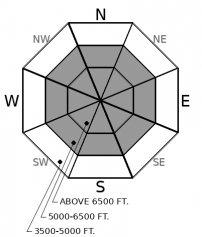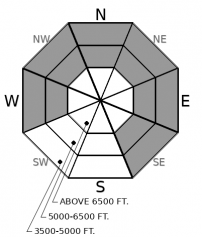| Monday | Monday Night | Tuesday | |
|---|---|---|---|
| Cloud Cover: | Mostly clear | Partly cloudy | Mostly clear |
| Temperatures: | 20 to 25 deg. F. | 2 to 7 deg. F. | 20 to 25 deg. F. |
| Wind Direction: | Shifting back to Southwest | Southeast - southwest | Southeast - southwest |
| Wind Speed: | 5 to 10, gusting to 20 | 5 to 10, gusting to 15 | 0 to 5 |
| Snowfall: | 0 in. | 0 in. | 0 in. |
| Snow Line: | 0 ft | 0 ft | 0 ft |
Whitefish Range
Swan Range
How to read the forecast
Spotty snowfall accumulations and breezy winds accompanied the arrival of a cold front yesterday afternoon. Swirling winds continue forming slabs on all aspects throughout our area. These will be thickest, and the avalanche danger higher, as you near the Continental Divide. Weak layers buried 1-2' below the surface remain a concern at low and mid-elevations. Evaluate new snow totals and look for drifting snow as you gain elevation. Areas sheltered from the wind will offer softer snow.

2. Moderate
?
Above 6500 ft.
2. Moderate
?
5000-6500 ft.
1. Low
?
3500-5000 ft.
- 1. Low
- 2. Moderate
- 3. Considerable
- 4. High
- 5. Extreme
-
Type ?
-
Aspect/Elevation ?

-
Likelihood ?CertainVery LikelyLikelyPossible
 Unlikely
Unlikely -
Size ?HistoricVery LargeLargeSmall

On Sunday, strong southwest winds buffeted the high country with reports of wind loading and fresh slabs that were easy to trigger. Shifting winds behind a passing cold front are forming slabs on atypical aspects (SE -NW). The area around Marias Pass received up to a foot of snow with most other locations receiving minimal amounts. Slabs will be thickest below ridgelines and in cross-loaded gullies. Fresh slabs will be sensitive to the weight of a rider or machine. Pay attention to new snow amounts and look for blowing snow as you gain elevation. Hollow sounding snow and cracking are signs of a slab formation with shooting cracks an obvious red flag. Softer snow can be found in areas sheltered from the wind.
-
Type ?
-
Aspect/Elevation ?

-
Likelihood ?CertainVery LikelyLikelyPossible
 Unlikely
Unlikely -
Size ?HistoricVery LargeLargeSmall

Observations from the weekend confirm that we are still dealing with a Persistent Slab problem. Impressive shooting cracks, collapsing and cracking on buried weak layers were reported from the Apgars, Canyon Creek, and the Flathead Range. FAC staff easily triggered persistent slabs 1-2’ deep on Friday in the northern Whitefish Range. Buried surface hoar and facets are most reactive between 4500’ and 6500’ within clearings on shady aspects. The danger is magnified on small slopes above terrain traps which allow even a shallow slide to pile up deep debris.
Change in the weather, change in the weather, something's happening here... Warm southwest flow arrived Saturday resulting in above normal temperatures for 24+ hours. Mountain locations hovered around freezing with the Pike Creek Snotel (5930’) recording 19 consecutive hours above freezing. The snow surface became moist and small wet snow issues developed. An increase in wind speeds Sunday resulted in Hornet recording 6 hours of gusts above 40 mph and Snowslip 4 hours of gusts greater than 43 mph. Putting this in perspective, wind speeds > 38 mph are Extreme. Resulting wind slabs are less than 24 hours old and found on “typical” leeward aspects (NW-SE). Due to the impressive wind speed, slabs may be found lower on the slope than normal. Mid-day Sunday, a cold front arrived plummeting mountain temperatures 15+ degrees and forming a crust on the moist snow surface. Accompanying NW - E winds are forming fresh thin slabs on atypical aspects.
Precipitation associated with the cold front was spotty but intense favoring the eastern end of our advisory area. Pike Creek received 1" of SWE/13" of snow, Fielding 0.77" of water and Shed 4 0.53" water and 4-5" of snow. Due to the new snow totals, the avalanche danger has risen to Considerable for the Flathead Range and Glacier Park. Large swaths of this terrain received little new snow and the danger will be closer to Moderate in these areas.
Melting and refreezing of the snow surface is a strengthening process helpful to our Persistent Slab problem. Buried facets and surface hoar slowly gain strength through warming and being squashed by the increasingly heavy overlying slab. A frozen snow surface helps distribute the weight of a rider across the surface with less of an impact, or stress, below the surface. Metamorphism is a slow process and we are certainly not out of the woods with our Persistent Slab problem but hopefully, we are heading in the right direction.
Sadly, 3 people died in avalanches in the western US on Friday. That brings the month's tally to 10, with 3 more in BC. Many of these accidents involved large or very large Persistent Slab Avalanches. These accidents are grim reminders that it's critical to keep your guard up and rely on safe travel practices to reduce your exposure. Our hearts go out to the families and friends of those involved.
EDUCATION: It's a great time to hone your avalanche knowledge or start learning the basics. Ladies Avalanche Awareness Talk - Kalispell Brewing Company -01/30/2019 6:30 PM.
Sign up for one of our upcoming classes: Motorized Introduction to Avalanches 01/31/2019 to 02/02/2019, Companion Rescue Clinic 02/09/2019 and Introduction to Avalanches (non-motorized) 02/28/2019 to 03/02/2019.
High temperatures will trend colder today as a colder air mass continues to filter across the Continental Divide. Skies will clear out this afternoon setting the stage for colder temperatures overnight. Little to no precipitation is expected during the work week.
This forecast applies only to backcountry areas outside established ski area boundaries. The forecast describes general avalanche conditions and local variations always occur. This forecast expires at midnight on the posted day unless otherwise noted. The information in this forecast is provided by the USDA Forest Service who is solely responsible for its content.































